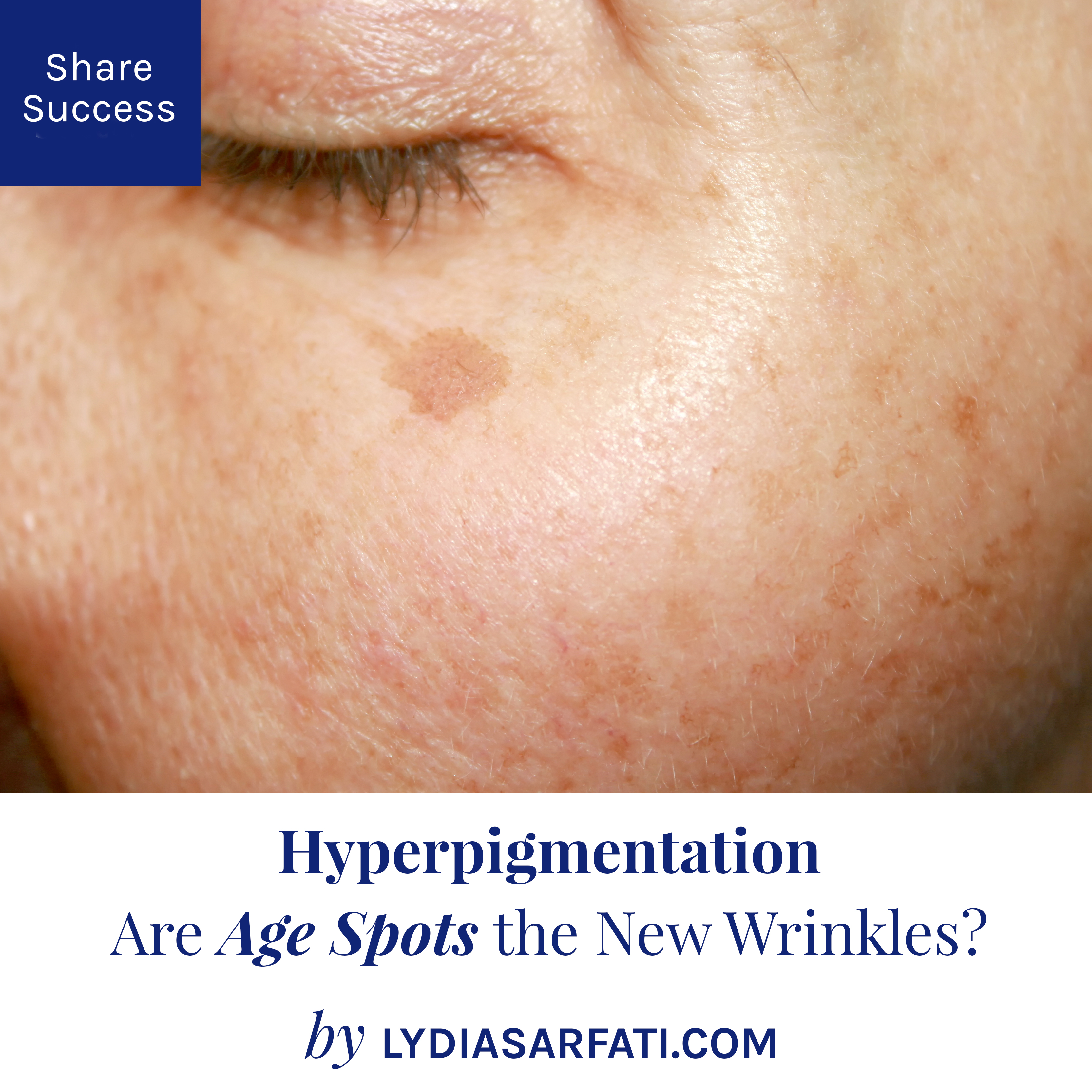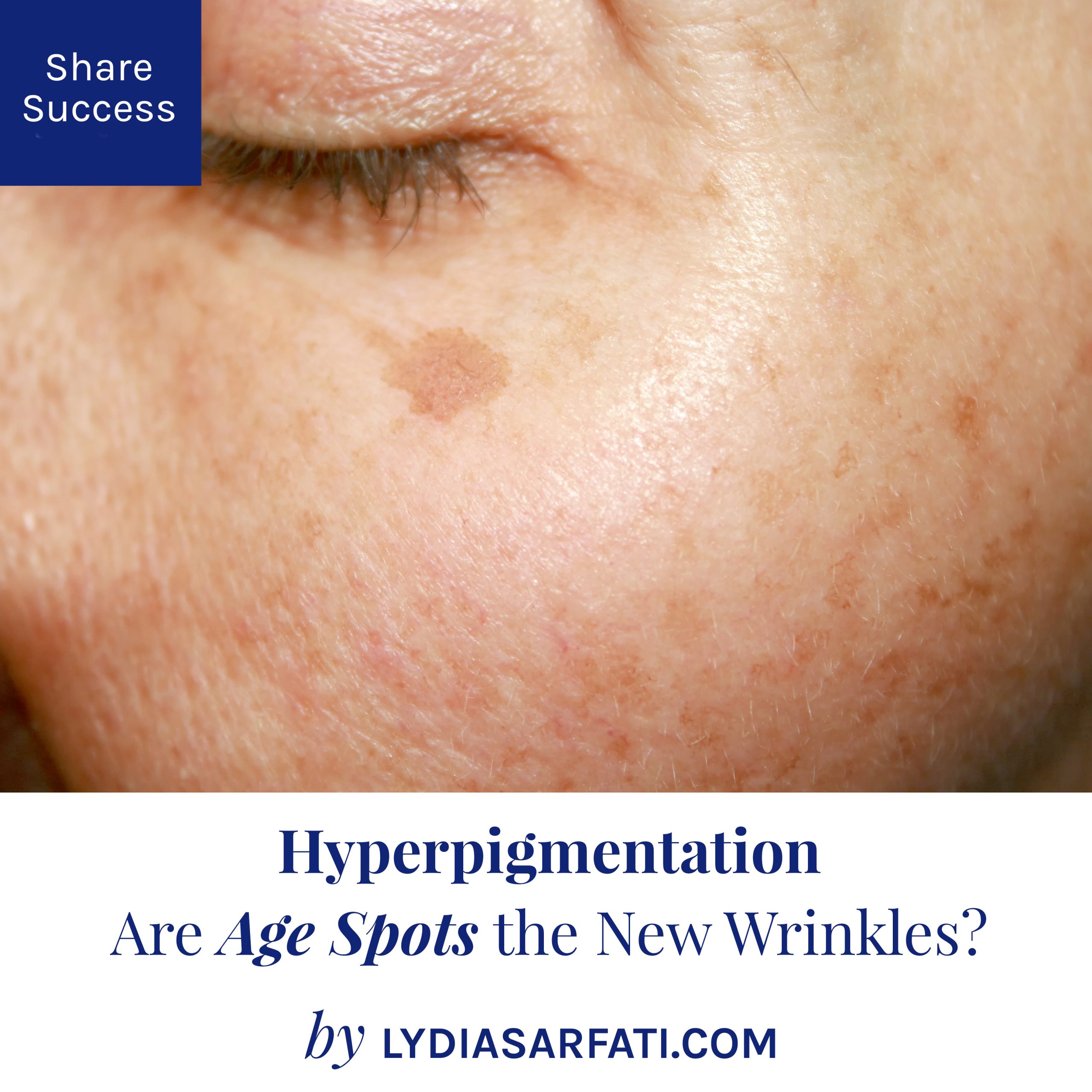
While historically women and men would come to the salon or spa at the sight of their first wrinkle, age spots that show up on face, hands and chest, are driving in more and more clients. Not only is the incidence of age spots increasing, the demographic is getting younger!
As a primary manifestation of photo-aging due to exposure to UV light, age spots is all too true a reality. The good news is that the appearance of age spots can be very effectively diminished, both professionally and in conjunction with a good skin care program.
Learn about the science behind age spots, what causes them, and professional treatments for age spots.
What are age spots?
Age spots or hyperpigmentation are the brown, gray or black spots that can appear on the skin. According to a study published in the Journal of the American Academy of Dermatology¹ hyperpigmentation can make you look up to 20 years older.
Often, age spots are accompanied by an overall dullness to the skin. In another study, researchers found that this lack of luminance and contrast within the skin tone also increased the likelihood of being perceived as older.

What causes age spots?
Age spots can be caused by a number of factors, including sun damage, specific types of medicine, hormonal changes and post-acne scarring.
UV Exposure
UV exposure can also contribute to uneven skin tone, hyper-production of more yellow and gray pigments in the skin (therefore skin is more yellow and gray), and loss of opacity to the skin, leading to dullness. And, while UV light is the primary culprit when it comes to causing age spots, other factors can contribute to hyperpigmentation and loss of luminance to the skin.
Smoking
Smoking generates free radicals and nitrosamines, decreases the amount of blood flow to the skin, increases wrinkling around the eye and mouth areas, contributes to a sallow complexion and weakens the blood vessels and immune system.
Hormones
Genetic and hormonal aging brings changes in estrogen and progesterone levels, which can trigger melasma. Post traumatic hyperpigmentation is caused by stress hormones, also common causes for changes in skin color.
Professional treatments for age spots: Chemical Peels
One of the most prevalent forms of addressing age spots is with chemical peels.
A chemical peel involves applying an acid, which removes the outer, superficial layers of your skin, evenly all over the skin. As your skin peels, new surface skin becomes visible.
Sallow, dull skin often accompanies age spots, and can be addressed at the same time in the same way. Dull skin is often the result of reduced cell turnover and accumulation of dead skin cells on the skin surface.
It is for this reason that chemical peels are often the method used to help reduce the appearance age spots and improve the appearance of dull skin.
Peels range from mild, at-home or in-salon treatments that require no downtime to intensive peels that can only be performed in a medical setting and demand several weeks of recuperation. The most important factor when considering various forms of chemical exfoliation is to consider the health of the skin’s natural protective barrier.
By their nature, chemical peels are intrusive to the skin’s protective barrier in varying degrees. Over-aggressive exfoliation, or improperly performed chemical peels can cause more damage to the skin than good, and this damage can be permanent.
What types of chemical peels can help age spots?
Deep Peels – Phenol Peels
Deep peels can only be performed by a medical professional in a medical setting. The most prevalent, and caustic deep facial peel is the Phenol peel. Phenol (carbolic acid) is a classic deep chemical peel that was discovered in 1900 to treat the appearance of acne scarring. Because phenol has a bleaching effect, it is recommended for those who have severe visible signs of photoaging, but it is not recommended for darker skin types or for those who have freckles.
Oral sedative and pain relievers, either through a shot or IV, are given, and general anesthesia may also be used. Because phenol is toxic when absorbed in large doses, a heart monitor and receive intravenous (IV) fluids are often administered. After the skin has been thoroughly cleaned, the chemical will be applied and allowed to penetrate. After one area of the face is treated, there will be a 15-minute break before the next area is treated to avoid getting too much phenol in one’s system.
Depending on how large an area is being treated, the entire procedure may take 60 to 90 minutes. After a phenol peel, the patient’s face will be bandaged, swollen and uncomfortable. Full recovery after a phenol peel can take up to a month. Skin must be soaked four to six times daily, followed by ointment application for the first 14 days. Antiviral medication is taken for 10 to 14 days. Patients will be advised to avoid all sun exposure for three to six months. Several follow-up appointments will be necessary to monitor progress.
Mid-level Peels – TCA Peels
TCA chemical peels are mid-level peels that involve applying Trichloroacetic acid to the skin. They are done on an outpatient basis, but may require light sedation depending on the concentration of the acid used. These are best for addressing the appearance of sun-damaged facial skin, fine lines, dark spots or hyperpigmentation, acne scars, and superficial facial scars.
TCA peels are applied in the same way as milder peels, but the acid used in TCA peels is much more potent, causing a more significant burn. Medium chemical peels are applied in the same way as light chemical peels: skin is prepped and cleansed, and then the chemical solution is applied left on the skin for short duration, depending on the needs of the patient. The solution is then washed away, and followed by an application of soothing ointment. Depending on the size of the area being treated, a medium chemical peel may take from 15 to 60 minutes to complete, though most treatments can be completed within 30 minutes.
After TCA peels, a superficial crust or “frost” forms over the treated area, a result of the TCA coagulating with the protein in the skin peels off within three to seven days. Healing time takes approximately two weeks. Treated skin will initially be red and swollen with swelling worsening for the first 48 hours. In some cases, eyelids may swell shut and blisters form. Skin crusts and peels off in seven to 14 days, and must be soaked daily followed by prescription ointment to aid in healing. Antiviral medication will be prescribed for 10 to 14 days.
Jessner’s Peel
Jessner’s peel solution, formerly known as the Coombe’s formula, was originally formulated by Dr. Max Jessner and has been in use for over 100 years. He formulated this solution out of several different chemicals including resorcinol (a chemical equivalent of phenol), salicylic acid (a beta hydroxy acid) and lactic acid (an alpha hydroxy acid) dissolved in ethanol to reduce the toxic effects of each individual component.
Jessner’s Peel is considered a superficial peel that is used to treat the appearance of photoaging, age spots, acne, post-inflammatory hyperpigmentation, melasma and freckles. Client may experience a warm, tingling or a burning sting during the application.
After application of peel, like with the TCA peel, skin may appear white and frosted. During the next few days the skin will appear red and progressively deepen to a tan/ brown color. Skin conditions during the peeling process may include mild stinging, mild swelling and redness, mild crusting and finally peeling. The skin can become very dry, tight and somewhat uncomfortable.
Retinoic Acid Peel
This type of facial peel is also performed in the office of a plastic surgeon, dermatologist or by these professionals in a medical spa setting. This is a deeper peel than the beta hydroxy acid peel and is used to help remove the appearance of scars as well as wrinkles and help improve the appearance of hyperpigmentation. It is usually performed in conjunction with a Jessner Peel. The client leaves with the chemical peel solution on their face. Once again, irritation and subsequent recuperation time is required, as well as diligent SPF use.
Alpha Hydroxy Acid (AHA) Chemical Peels
Alpha hydroxy acids (AHA) are a group of organic carboxylic compounds, typically derived from food products including glycolic acid from sugar cane, lactic acid from sour milk, malic acid from apples, citric acid from citrus fruits, and tartaric acid from grapes.
Glycolic acid penetrates the surface layers of the skin and loosens the dry, thick skin that makes the complexion look aged and dull. Glycolic acid, in concentrations of 5% to 10% was found to help promote skin exfoliation to create a smoother texture. Solutions of 10% and 50% help with additional skin smoothing. High concentrations, only used under medical supervision, create a strong glycolic peel to help reduce the appearance of sun damage and hyperpigmentation.
Beta Hydroxy Acid (BHA) Chemical Peels
These use salicylic acid for a less irritating peel. Often used in conjunction with other peeling ingredients, such as in the Jessner peel, these are beneficial for helping reduce the appearance of sun damage and age spots.
Chemical Peels for the Salon
For an in-salon chemical peel that is performed by a licensed esthetician, a formula with 30% Glycolic acid with a pH of 3.5, like found in Repêchage® Biolight® Glyco-Sea® Glycolic Peel, can be used to help minimize irritation that may result from the peel.
There are even natural chemical peels that use natural-based ingredients to provide skin with gentle, yet effective, exfoliation. Next week I will discuss a hybrid peels, a new type of chemical peel that can be performed in a salon.
In conjunction with chemical peels, a professional brightening facial and a proper home care with skin brightening ingredients can help age spots and hyperpigmentation.
What are you using to treat clients with age spots? Share with me below!
1. Matts PJ, Fink B, Grammer K, Burquest M. “Color Homogeneity and Visual Perception of Age, Health, and Attractiveness of Female Facial Skin.” J Am Acad Dermatol. 2007 Dec;57(6):977-84
2. Porcheron, A., Mauger, E., Russell, R., “Aspects of Facial Contrast Decrease with Age and Are Cues for Age Perception,” PLOS 2013 Mar 6.
Reprinted from “Are Age Spots the New Wrinkles?” published in Dermascope Magazine, May/2017.
